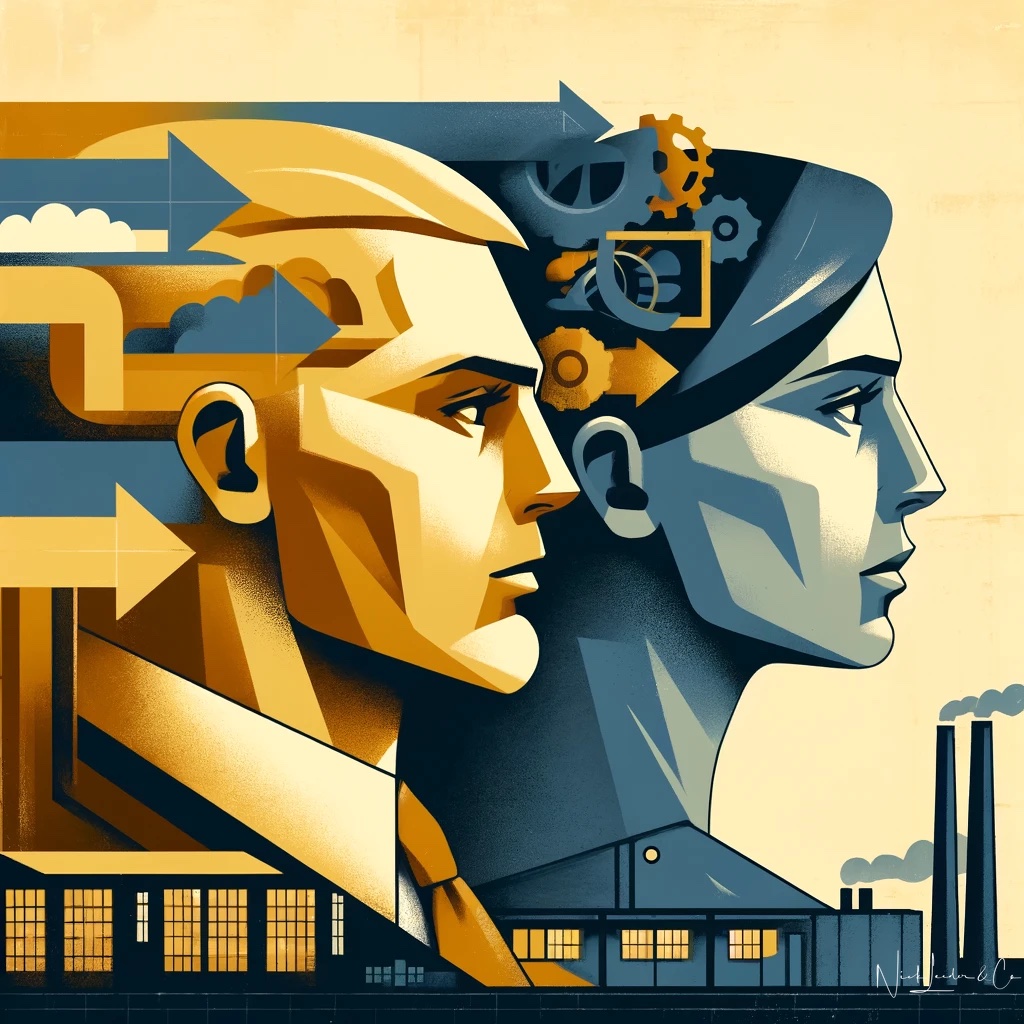If you only have a minute to uncover manufacturing’s diversity crisis
Recent observations have heightened our awareness regarding the subtle yet persistent gender biases in the manufacturing sector. In our ongoing efforts to create compelling blog content for the recent HiveMind webinar, we leverage AI tools like ChatGPT and DALL-E 2 to generate both the narratives and visuals focused on manufacturing and digital transformation. This exercise, however, revealed a concerning pattern in the portrayal of manufacturing roles.
During our analysis, we generated several images to depict a “manufacturing leader” and a “worker” standing side-by-side in a factory setting. The simplistic request returned images predominantly featuring white male figures in both roles— the leader often depicted as a grey-haired man in a suit. This repetitive imagery raises significant concerns about the stereotypical representation prevalent in online data and, by extension, the manufacturing industry at large.
This discovery prompted further exploration into the gender disparities within the sector. Reports from reputable sources like the Cambridge Industrial Innovation [1] Policy, The Century Foundation [2], and McKinsey[3] highlight that only about 26% of roles in the UK manufacturing sector are occupied by women. The salary gap is also stark, with women earning approximately 17% less than their male counterparts for equivalent roles. Moreover, racial disparities add another layer of concern, with women of non-white backgrounds constituting a mere 3% of the workforce.
The path to inclusivity in manufacturing must extend beyond policy adjustments to address these systemic biases effectively. It requires a fundamental shift in organisational culture to ensure every employee feels valued and respected. Flexibility in work arrangements, previously challenged during the COVID pandemic, emerged as a critical factor in enhancing work-life balance and attracting a more diverse workforce.
As we navigate these challenges, the manufacturing sector stands at a crossroads between traditional practices and progressive change. Embracing digital transformation can play a pivotal role in making organisations more inclusive and attractive to diverse talent pools, including young female professionals.
In conclusion, the journey towards a more inclusive manufacturing sector involves revisiting our cultural norms, addressing microaggressions, and actively promoting diversity through strategic decisions. This isn’t just a visionary goal; it’s a necessary blueprint for the future of manufacturing. By championing these changes, companies can differentiate themselves as leaders in innovation and inclusivity within the industry.
Uncovering the manufacturing diveristy crisis through DALL·E 2
Over the past few weeks we have been producing the latest series of Transformation Tuesday posts from the recent HiveMind Webinar we did. We have started in our journey using AI content and imagery to help accelerate the creation of engaging web and LinkedIn Posts.
We noticed something odd as we created the images to support the posts using the DALL·E 2 AI system….
We use a repeatable prompt to created these images as you can see below. We mention the terms “manufacturing leader” and “manufacturing worker” and some additional information to provide some detail and context to the image:
Create an image of a manufacturing leader and a manufacturing worker standing side-by-side in a modern factory. They are stood next to a machine with a red Andon light flashing and the manufacturing worker is looking at their iPad looking at what might be wrong. Make the image photo-realistic and make the main colours #DEA800 and #49545C
DALL·E 2 Prompt used
As you can see from the text above, there was not reference to racial or gender preference in the language used.
Can we make it change?
In the final image produced below, we asked DALL·E 2 to modify the image by highlighting the person and asking the prompt
make this person to break the gender biases in manufacturing
DALL·E 2 Prompt used to refine the image

The end result?
Apart from the manufacturing leader looking like a McKinsey consultant, when we forced DALL·E 2 to make the changes, it did effectively make the changes needed.


This got us thinking… Is Manufacturing Diversity Crisis An Unseen Advantage?
Underrepresentation is More Than a Number Game
In the UK’s manufacturing landscape, women constitute a mere 26% of the workforce, with their earnings lagging by 17% behind their male counterparts (Cambridge Industrial Innovation Policy). But it’s not just about gender. Women from non-White backgrounds and those with disabilities find even less representation, holding 3% and less than 1% of manufacturing jobs, respectively. These figures are not just statistics; they are a mirror to the systemic barriers that stifle talent and innovation in our factories and workshops.
The Cost of Microaggressions
The McKinsey & Company report highlights a troubling trend: women, especially those from Asian and Black backgrounds, are seven times more likely to be subjected to microaggressions compared to their White counterparts. Such demeaning encounters not only undermine psychological safety but also catalyse stress, job dissatisfaction, and high turnover rates. For manufacturing leaders, this should ring alarm bells 🛎️, signalling the urgent need to cultivate a workplace where respect and inclusivity are not just preached but practiced.
Flexibility: A Keystone for Inclusivity
Remote work and flexible hours are not just pandemic-era stopgaps but crucial levers for fostering an inclusive work environment. With 38% of mothers citing the lack of flexibility as a potential career deal-breaker, the case for adaptable work arrangements has never been stronger. The future of manufacturing must be built on the foundation of work-life balance, enabling all employees, irrespective of their gender or caregiving responsibilities, to thrive.
For manufacturing leaders, these findings underline a critical message: embracing diversity and inclusivity is not merely a checkbox exercise but a strategic enabler of innovation, resilience, and competitiveness.
Key Action Steps 🌈
In the face of these insights, manufacturing leaders are called upon not just to acknowledge but to act decisively. Here are three actionable steps to harness the power of diversity and set your operations apart:
1. Champion Inclusive Digitalisation
Embrace technology with an eye towards inclusivity. Ensure that digital transformation efforts within your operations actively promote gender diversity and provide equal opportunities for all employees. This could mean investing in upskilling programs, mentorship, and leadership pathways specifically designed for underrepresented groups. By doing so, you’re not just future-proofing your workforce; you’re building a culture of innovation that draws strength from diversity.
2. Eradicate Microaggressions
Commit to a zero-tolerance policy for microaggressions. This means going beyond workshops and trainings to foster a culture where every employee feels valued and respected. Implementing anonymous reporting channels, instituting swift disciplinary actions, and regularly soliciting feedback on the work environment can transform your factory floor from a place of mere production to a hub of creativity and mutual respect.
3. Flexibility as a Non-Negotiable
Redefine your work policies to make flexibility a core tenet, not an afterthought. Whether it’s offering remote work options, flexible shifts, or supportive policies for parents and caregivers, the goal is to create an environment where everyone, regardless of their personal circumstances, has the opportunity to excel.
In Conclusion…
By taking these steps, manufacturing leaders can not only address the pressing issues of diversity and inclusivity but also unlock a reservoir of untapped potential and creativity. The journey towards a more inclusive manufacturing sector is challenging, no doubt, but it’s also ripe with opportunities for those willing to lead with empathy, vision, and courage. The future of manufacturing is inclusive, and the time to build that future is now. Let’s get to work! 🛠️
Find out more about Nick Leeder & Co
Nick Leeder & Co is dedicated to empowering businesses in the manufacturing sector. By implementing industry-leading techniques like IGNITEIt! incorporating the Smart Industry Readiness Index, companies can streamline their operations, optimise processes, and deliver high-quality products to the market faster than ever before.
Whether it’s enhancing efficiency, embracing new technologies, or fostering a culture of continuous improvement, Nick Leeder & Co is at the forefront of supporting UK manufacturers in their digital transformation journey. We co-pilot manufacturers through their transformations to successful outcomes and bring decades of front-line experience in delivering changes in complex and global organisations to bear.
So, join the transformation revolution and unlock the true potential of your manufacturing business with Nick Leeder & Co’s transformative solutions and learn more about the power of digital manufacturing in our blog series “Transformation Tuesdays“.

Postscript: Some additional observations were made.
In a recent Transformation Tuesday post, we made sure the imagery was more inclusive. The sharp-eyed people amongst us will note that DALL·E 2 created the image of a “female manufacturing worker” wearing high heels. This is both a massive gender bias and, as we all know, also a health and safety issue when it comes to the shop floor working practices. Like above, we highlighted the offending area and asked DALL·E 2 to “make the shoes safety shoes” and all is made good! Credit to Ian Clarke for spotting that one!


Th












